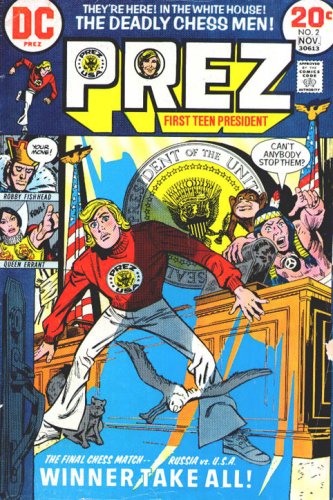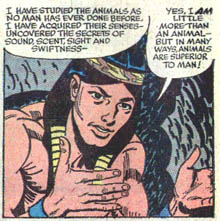

One comic I never read from the 1970s was PREZ, about the first teenage president. A correspondent recently brought it to my attention:
and make sure to click on Eagle Free's name for a stereotype-laden panel.
If he's not somewhere in the "Blue Corn Comics", I think he should be for completeness' sake.
"Anonymous" replies
Another correspondent offered some thoughts on Eagle Free and the following exchange ensued:
It might be possible to spin some positive things out of Eagle Free:
1) His "Yes, I am little more than an animal" is more likely to refer to something that is very unique to him (and not other Natives) and belongs in the context of the rest of the panel. In this, he claims "I have studied the animals as no man has ever done before" and has uniquely gained powers from them like a land-based Aquaman or another Animal Man. He does not speak as this connection to animals is anything typical of his people. This seems more likely than a stereotypical context of some sort of "animalistic savage"

2) Whether or not it is inattention by the writer, his dialogue appears to lack any sort of connection to stereotypes ranging from the "Indian in the Cupboard" to the Yoda-like medicine man speaking in riddles. He just talks like a normal guy.
3) As the head of the FBI, he has probably reached a pinnacle of real political power not reached by other Native comic characters (even if it is in his role of a "Tonto" sidekick to the golden-boy Prez).
Did you look at all the panels? In one, Prez admits thinking Eagle Free is little more than an animal. In another, Prez calls him a "savage" and Eagle Free doesn't directly contradict him. The comic is stereotyping Indians even if Eagle Free doesn't do it himself.
One panel compares Eagle Free to different animals. It even says he has the strength of a "primate ape," an animal not native to America. Hello? Haven't we learned by now that comparing humans to apes is insulting?
The whole idea of Natives being in tune with Nature is somewhat stereotypical. Even if there's an explanation, even if it's unique to Eagle Free, it doesn't change the point.
Eagle Free dresses in literally the most stereotypical fashion: buckskin pants, bare chest, single feather stuck in a headband. He lives in a tepee, another egregious stereotype. As head of the FBI, it must be tough phoning agents, writing memos, or going to the bathroom out on the lawn. But hey, Eagle Free can't help it. He's natural!
I concede that PREZ tried to tear down the stereotypes it created by showing Eagle Free in a positive light. But many comics, cartoons, and movies try to show their stereotypical Indians in a positive light. The positive traits don't eliminate the stereotypes, they only confound them.
I can't prove it, but I suspect readers are more likely to pick up the negative traits than the positive ones. A half-naked Indian who acts like a savage and consorts with animals is a picture that reinforces 500 years of stereotyping. An Indian who speaks normally and heads the FBI is a rare occurrence that fades quickly from the mind. (The correspondent who brought Eagle Free to my attention didn't even remember him.)
So which traits are most likely to stick with the typical reader? Experience suggests the negative ones will dominate his mental image of Indians.
The discussion continues....
You are right. I didn't even attempt to find anything positive about Eagle Free's appearance and abode: because there isn't anything positive about it. If the comic had continued, an interesting twist would have been for some real Natives to show up, laugh at Eagle Free's appearance, and then discover that Eagle Free's one of those fake Indians. However, silly as PREZ was, I think later issues would have tended toward the silly instead of the thought-provoking.
Having real Indians show up and put the lie to the stereotypes might work. After all, PREZ was contemporary with Wounded Knee II. What would Dennis Banks or Russell Means have said if they met Eagle Free?
But alas, this approach doesn't register with people in reality. How often have protesters pointed out that they don't look like Chief Wahoo or Chief Illiniwek? It doesn't seem to make any difference.
Related links
Comic books featuring Indians
|
. . . |

|
All material © copyright its original owners, except where noted.
Original text and pictures © copyright 2007 by Robert Schmidt.
Copyrighted material is posted under the Fair Use provision of the Copyright Act,
which allows copying for nonprofit educational uses including criticism and commentary.
Comments sent to the publisher become the property of Blue Corn Comics
and may be used in other postings without permission.